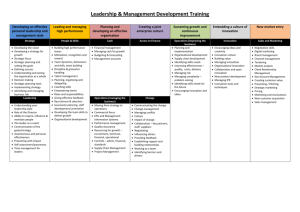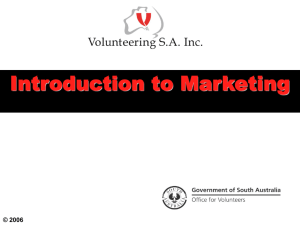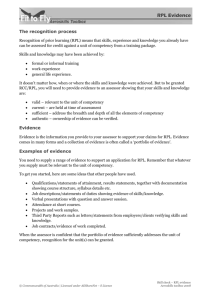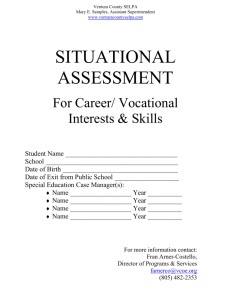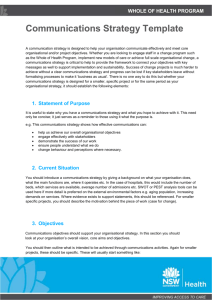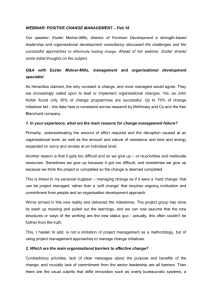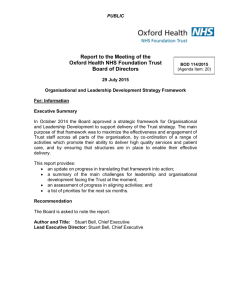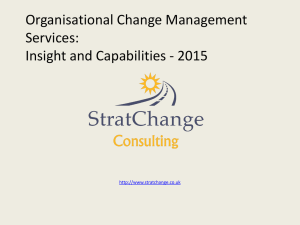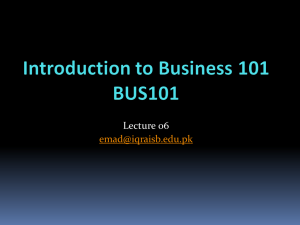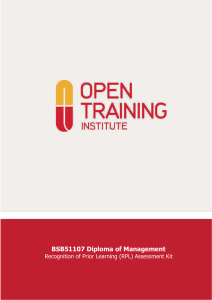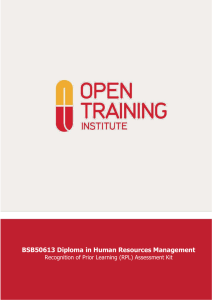Skills Check
advertisement
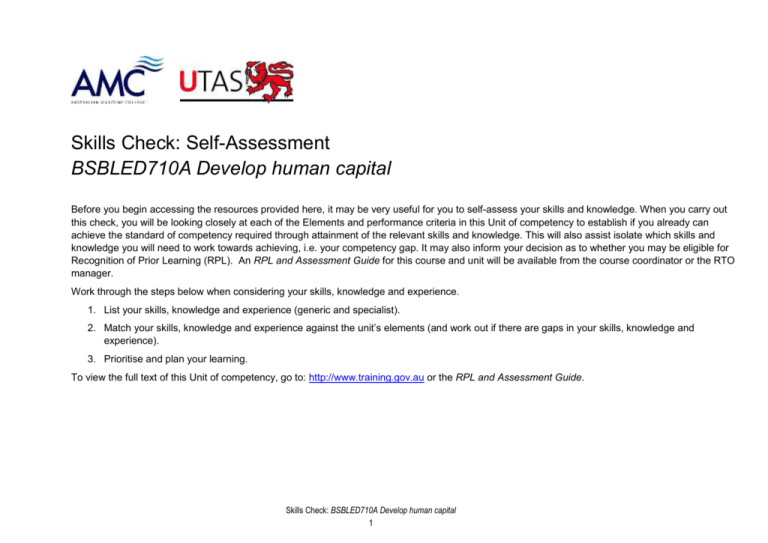
Skills Check: Self-Assessment BSBLED710A Develop human capital Before you begin accessing the resources provided here, it may be very useful for you to self-assess your skills and knowledge. When you carry out this check, you will be looking closely at each of the Elements and performance criteria in this Unit of competency to establish if you already can achieve the standard of competency required through attainment of the relevant skills and knowledge. This will also assist isolate which skills and knowledge you will need to work towards achieving, i.e. your competency gap. It may also inform your decision as to whether you may be eligible for Recognition of Prior Learning (RPL). An RPL and Assessment Guide for this course and unit will be available from the course coordinator or the RTO manager. Work through the steps below when considering your skills, knowledge and experience. 1. List your skills, knowledge and experience (generic and specialist). 2. Match your skills, knowledge and experience against the unit’s elements (and work out if there are gaps in your skills, knowledge and experience). 3. Prioritise and plan your learning. To view the full text of this Unit of competency, go to: http://www.training.gov.au or the RPL and Assessment Guide. Skills Check: BSBLED710A Develop human capital 1 Step 1: List your skills, knowledge and experience Think about the different workplaces you have worked in, when and the type of work you did. Tips: Be sure to include workplaces that are not necessarily related to the industry you are currently working in as well as experiences in places outside of the paid workforce. As you list your skills and knowledge, you’ll find it useful to have your résumé and/or any documents such as letters of reference that contain information about your experience. Summarise your overall experience. Workplace and period Type of work Skills Check: BSBLED710A Develop human capital 2 Skills, knowledge and experience Step 2: Match your skills, knowledge and experience against the Elements of competency Using the tables below, work out your skills and knowledge gap in relation to each Element of competency for this unit: BSBLED710A Develop human capital. Begin by reading each performance criteria in the first column and reflect on what it means, using the information provided in the second column. Then reflect on whether you have demonstrated the skills and knowledge required by the performance criterion. If you do have skills and experience directly related to the performance criterion, note examples (of qualifications, training, experience, etc). You may find that you have not ticked all or some of the performance criteria. This gives you an indication of where your skills gaps lie. You will need to go to the Study Guide and resources relevant to the Element you need help with. As you work through a Study Guide activities access the readings, textbook and other resources (video, etc.) to support your learning. If you find that you have said ‘Yes, I do have the skills/knowledge’ for all of the performance criteria, then you may not need to work through the Study Guide. You will then need to decide whether you should go directly to close gaps or undertake the assessment tasks. You may even prepare an RPL assessment. Skills Check: BSBLED710A Develop human capital 3 Element 1: Identify human capital Performance criteria 1.1. Analyse and evaluate the principles of human capital theory and concepts What this could mean… Evidence relating to this performance criterion I have the skills/ knowledge Human capital is the: □with guidance □independently □lead others □ Yes □ No capital asset value of knowledge vested in the individual that can be deployed to maximise organisational and industry competitiveness □with guidance □independently □lead others 1.2. Assess the factors involved in the formation of human capital 1.3. Determine the capital asset value of human resources in an organisation, an industry or a region 1.4. Determine the relationship between human capital and organisational requirements Evidence: Evidence: Capital asset value is the: determination of the value a business may derive from any stock of assets it owns, which can be deployed to create income, or from which interest and future value can be derived □with guidance □independently □lead others Organisational requirements may include: access and equity principles and practices business and performance plans collaborative partnerships and arrangements confidentiality requirements defined resource parameters ethical standards goals, objectives, plans, systems and processes legal and organisational policies, guidelines and requirements OHS policies, procedures and programs organisational sociocultural circumstances and issues (for example, within Indigenous organisations) quality and continuous improvement processes and standards quality assurance and procedures manuals recording and reporting procedures □with guidance □independently □lead others Evidence: Evidence: □ Yes □ No □ Yes □ No □ Yes □ No If you do not meet the requirements for this element move ahead to complete your Study Guide and access the relevant resources. Your leadership — if you feel confident you meet the requirements for this element, and begin preparing or gathering evidence for an RPL application or assessment. Skills Check: BSBLED710A Develop human capital 4 Element 2 Consult on the advantages of human capital development Performance criteria 2.1. Develop and prioritise strategies for deploying human capital development strategies to support the organisation training needs profile in consultation with key stakeholders What this could mean… Evidence relating to this performance criterion I have the skills/ knowledge Organisation training needs profile may include: areas where staff may require further development linked to the organisation’s goals and reflect: age profile composition – full-time, part-time, casual formal education and training backgrounds gender ratio language and cultural backgrounds occupational groups organisational change programs roster and shiftwork arrangements Key stakeholders may include: customers instructional designers instructors learners management and staff members of the public peers public agencies, especially regulators suppliers and learning partners □with guidance □independently □lead others □ Yes □ No □with guidance □independently □lead others 2.2. Negotiate with key stakeholders on opportunities for collaborative human capital development projects Evidence: Evidence: □ Yes □ No If you do not meet the requirements for this element move ahead to complete your Study Guide and access the relevant resources. Your leadership — if you feel confident you meet the requirements for this element, and begin preparing or gathering evidence for an RPL application or assessment. Skills Check: BSBLED710A Develop human capital 5 Element 3 Develop and monitor human capital development Performance criteria 3.1. Complete human capital needs analysis and development planning according to organisational requirements 3.2. Analyse and interpret information and data on human capital gaps and forecasts 3.3. Implement options and strategies to develop, attract and retain talent What this could mean… Evidence relating to this performance criterion I have the skills/ knowledge Human capital needs analysis is the: determination of the gap between the human capital an individual, group, organisation or wider grouping (e.g. society or industry) requires as opposed to what is currently available □with guidance □independently □lead others □ Yes □ No Information and data analysis will usually occur through deployment of information technology and data applications able to assess human capital using analysis methods such as: data sampling feedback on results peer review qualitative and quantitative processes review of previous research statistical analysis Options for the purposes of human capital development planning may include: availability of resources, such as financial resources, and information technology and systems consultancy services developing in-house capacity to meet identified needs identifying training or assessment organisations to meet needs identifying specific units of competency, Australian Qualifications Framework (AQF) qualifications or skill sets to meet needs time lines urgency □with guidance □independently □lead others Evidence: Evidence: □with guidance □independently □lead others Evidence: □ Yes □ No □ Yes □ No Talent concerns the: total potential an individual brings to an organisation within both current and future contexts 3.4. Implement options and actions to optimise asset value of human resources in relation to organisational strategic imperatives □with guidance □independently □lead others 3.5. Determine talent and develop the potential of human capital required to meet organisational requirements □with guidance □independently □lead others Evidence: Evidence: Skills Check: BSBLED710A Develop human capital 6 □ Yes □ No □ Yes □ No 3.6. Promote the capacity of the organisation, team and individual employees to achieve strategic and personal advantage through effort to develop human capabilities Capacity includes: all innate and explicit competencies and capabilities able to be deployed to achieve desired outcomes in both current and future contexts □with guidance □independently □lead others Evidence: □ Yes □ No If you do not meet the requirements for this element move ahead to complete your Study Guide and access the relevant resources. Your leadership — if you feel confident you meet the requirements for this element, and begin preparing or gathering evidence for an RPL application or assessment. Skills Check: BSBLED710A Develop human capital 7
